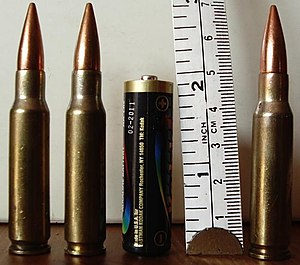7.62 × 51 mm NATO
| 7.62 × 51 mm NATO | |
|---|---|

|
|
| general information | |
| caliber | 7.62 x 51 mm |
| Sleeve shape | Bottle neck sleeve, rimless with pull-out groove |
| Dimensions | |
| Sleeve shoulder ⌀ | 11.53 mm |
| Sleeve neck ⌀ | 8.73 mm |
| Floor ⌀ | 7.85 mm |
| Cartridge bottom ⌀ | 12.01 mm |
| Sleeve length | 51.18 mm |
| Cartridge length | 71.05 mm |
| Weights | |
| Bullet weight | 9.4 to 11.66 g (145 to 180 grain ) |
| Powder weight | 3.00 g |
| total weight | 24.00 g |
| Technical specifications | |
| Speed v 0 | 785 m / s |
| Max. Gas pressure | 4150 bar |
| Bullet energy E 0 | 3500 y |
| Lists on the subject | |
The 7,62 × 51 mm NATO cartridge is a rifle cartridge developed from the civilian .308 Winchester and widely used in the military.
In December 1953 it was introduced as a standard NATO cartridge. It was one of the most widely used cartridges in the western world until the 1980s.
development
The cartridge 7.62 × 51 mm was developed to replace the .30-06 Springfield cartridge by Frankford Arsenal from the .300 Savage . The Winchester company offered this cartridge for the first time in 1951 under the civil name .308 Winchester . In December 1953 it was introduced as a standard NATO cartridge. In 1957 the cartridge - the first cartridge for handguns - was standardized as the NATO Standard 2310 . With the release of STANAG 2310 for SEATO in 1959, the standardization was extended to Australia.
In the German Bundeswehr , the cartridge is mainly used in the Heckler & Koch G3 assault rifle and the MG3 machine gun .
use
The center fire cartridge is also known as the 7.62 × 51 mm CETME / NATO . In NATO-affiliated and NATO-affiliated armed forces, it was replaced for use in assault rifles by the small-caliber 5.56 × 45 mm NATO and is mostly only used in machine guns and telescopic rifles . Here, too, the trend is towards light machine weapons such as the M249 SAW or the MG4 . Universal machine guns such as the FN MAG , M60 , MG 74 or the MG3 in caliber 7.62 × 51 mm are used as support weapons at platoon level , while new developments such as the MG5 are standard among mechanized forces at group level. The cartridge is also experiencing a renaissance to a certain extent due to the increasing use of modernized rapid-fire rifles . These include, for example, various newer versions of the American M14 or completely new developments such as the HK417 , SG SAPR or FN SCAR . It seems that the cartridge could establish itself as a niche solution in Designated Marksman Rifles , at least in the medium term . This is mainly due to field experience in which the 5.56 mm cartridge has proven to be too weak. In Afghanistan, for example, fighting is often done at a distance of between 300 and 500 meters, for which the 5.56 mm caliber is insufficient.
Furthermore, the 7.62 × 51 mm NATO is used in sniper rifles . However, there are signs - especially in the military sector - a change to the stronger .338 Lapua Magnum . In the police environment - for example in PSG1 - it continues to be the dominant cartridge in the western world.
Related medium-caliber cartridges for hunting rifles are the originally military .30-06 Springfield (7.62 × 63 mm), the .300 Winchester Magnum (7.62 × 66.5 mm) and the .338 Winchester Magnum (8.5 × 63.5 mm) and the .308 Norma Magnum (7.62 × 65 mm BR).
variants
.308 Winchester
Since the .308 is the civil version of the 7.62 × 51 mm, there are only minor differences between the two cartridges. The biggest difference is the marking, as there are no caliber indications on the military version. Only the NATO cross, a manufacturer identification and a lot or year number are embedded in the case base . The missing caliber information is printed on military cartridges that are sold on the civilian market.
Technical differences are the flatter case shoulder of the .308 as well as thinner wall thicknesses, which can lead to problems when firing the military cartridge from precisely manufactured weapons. In addition, the charges and projectiles of the military ammunition are subject to strict specifications, which leads to a lower availability of different projectiles and charges than with the .308.
7.62 × 51 mm CETME / NATO
The Spanish military cartridge 7.62 × 51 mm CETME / NATO was first used in the CETME A and CETME B assault rifles . It has a reduced charge compared to other cartridges manufactured by NATO . This then generally leads to weapon malfunctions if an attempt is made to fire ammunition from weapons other than the CETME A or CETME B.
Web links
- 7.62 × 51 mm NATO on Waffeninfo.net
- The .308 Winchester / 7.62 × 51mm NATO on WaffenHQ
- Technical specifications for 7.62 NATO (in Czech) ( Memento from May 3, 2018 in the Internet Archive ) at oos-data.army.cz
Individual evidence
- ↑ CIP 308 Win. (PDF, 110 kB) ( Memento from June 23, 2017 in the Internet Archive )
- ^ Friedhelm Kersting: reloading: preparation and practice . 5th edition. DEVA, 2005, ISBN 3-00-016629-7 , pp. 310 .
- ↑ NATO: MCM-0160-1959_ENG (PDF, 583 kB) ( Memento from May 3, 2018 in the Internet Archive )
- ^ Greg Grant: Taking Back the Infantry Half-Kilometer. In: defensetech.org. Military.com, March 31, 2010, accessed June 26, 2011 .
- ↑ 7.62x51mm NATO or 308 Winchester? What's the difference? Retrieved September 14, 2018 .


